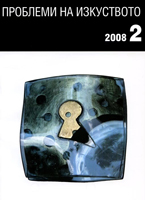Някои иконографски проблеми на българската живопис през 60-те години на ХХ век
Some Iconographic Problems in Bulgarian Painting During the 1960 s.
Author(s): Boyka DonevskaSubject(s): Cultural history
Published by: Институт за изследване на изкуствата, Българска академия на науките
Summary/Abstract: With respect to the general dynamics in Bulgarian art, the 1960s stand out as a period with an exceptionally interesting socio-cultural profile. The processes characteristic of the decade are connected to increased activity in artistic life, with increasing complexity in the content and formal issues in art, and with an interest in experimentation and original expression. At the same time, precisely this “multifacetedness” of individual expressions is one of the reasons behind the search for general cultural belonging with in the “tendency towards a national style”. The majority of its representatives discover a connection with medieval, Renaissance and folk art in iconography and the stable parameters of a style that directs the path of the communicative process. From an iconographic point of view, in the founding of the national image the following elements play major roles: strict composition, strong sculptural forms, absolute staticness and the expressivity of the gesture. Thus compositions of Christian art, stably encoded within iconographic systems, are used by contemporary artists in a new historical context. With respect to concrete solutions, one can observe several basic approaches. Some of the artists use general schemata of the iconographic type, while concretizing the event chronologically with real details. Other works function in a different manner; there, the symbolism is encoded as a whole, without a hint at a modern reading of the motive. The drive to achieve new pictorial expression, which would take on the idea of con temporary and at the same time authentic (national) art, also leads to reconstruction of the national artistic form. In many of the paintings, the essence of the work arises from the aestheticization of the form, where the linear-rhythmic and spatial principles are analogical to those of icon painting, miniatures, Renaissance prints and folk art. Besides in historical painting, individual compositional techniques and stylistic methods also come close to works from other genres - everyday composition, landscapes and still lifes, which demonstrate the general preference for an associative artistic language. Towards the end of the decade, however, the ubiquitous exploitation of these ready made models led to a certain balancing of solutions, grouped around a small number of iconographic schemata, which soon out lived their founding.
Journal: Проблеми на изкуството
- Issue Year: 2008
- Issue No: 2
- Page Range: 32-41
- Page Count: 10
- Content File-PDF

